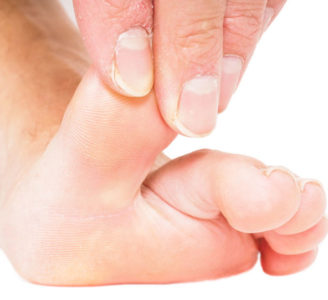 Hammer toes are a condition categorized by a contracture or bending of a toe at the first joint of the toe, also known as the proximal interphalangeal joint. The bending forces the joint upwards and gives it the appearance that the individual is scrunching their toe on purpose, but oftentimes the contracture is involuntary. In its earlier stage, a more mobile hammer toe is called a flexible hammer toe. If it progresses to a more serious or even permanent state, it’s considered a rigid hammer toe. Today, we take a look at the two different types of hammer toes.
Hammer toes are a condition categorized by a contracture or bending of a toe at the first joint of the toe, also known as the proximal interphalangeal joint. The bending forces the joint upwards and gives it the appearance that the individual is scrunching their toe on purpose, but oftentimes the contracture is involuntary. In its earlier stage, a more mobile hammer toe is called a flexible hammer toe. If it progresses to a more serious or even permanent state, it’s considered a rigid hammer toe. Today, we take a look at the two different types of hammer toes.
Types Of Hammer toes
As we alluded to above, there are two types of hammer toes:
Flexible Hammer Toes – This is the first stage of the general condition known as a hammer toe, and it is considered the less serious form because the individual can still move the joint at will. Treatment at this stage can help prevent a rigid hammer toe from setting in.
Rigid Hammer Toes – This is the final form of a hammer toe and it is the more serious condition. Rigid hammer toes generally involve individuals who did not seek treatment for their flexible hammertoe, or those who have severe arthritis in their joints. In a rigid hammer toe, the tendons in the toe have become very tight, so much so that the interphalangeal joint has become misaligned and immobile. Surgery is generally the only course of treatment that can spell relief for rigid hammer toes.
Causes And Symptoms Of Hammer Toes
At the base level, a hammer toe develops because there is an abnormal balance of muscles in the toe. This abnormal balance puts increased pressure on certain joints and tendons in the toe, which eventually lead to contracture. This can be brought upon by genetics, trauma, overuse or the development of arthritis. Wearing tight shoes that push back on the toes can also lead to the development of hammer toes.
Symptoms of hammer toes include:
- Pain at the joint of the toe
- A raised appearance at the IP joint
- Redness
- Swelling
- Restricted motion at the joint
Treatment of Hammer Toes
If you suspect that you’re beginning to deal with the onset of a hammer toe, take care of it before it turns into a much bigger problem. Aside from consulting with a foot specialist, make sure you’re wearing large enough shoes so your toes aren’t cramped, and put ice on the joint a couple times each day to decrease swelling. Additionally, you can do some range of motion or toe stretching exercises to help maintain mobility in the joint.
If conservative treatment fails or you’re dealing with a rigid hammer toe, surgery may be the best option to provide relief. During surgery, the surgeon will work to remove the bony prominence and restore the toe joint back to a healthy alignment, which should decrease pain and give it an improved appearance.